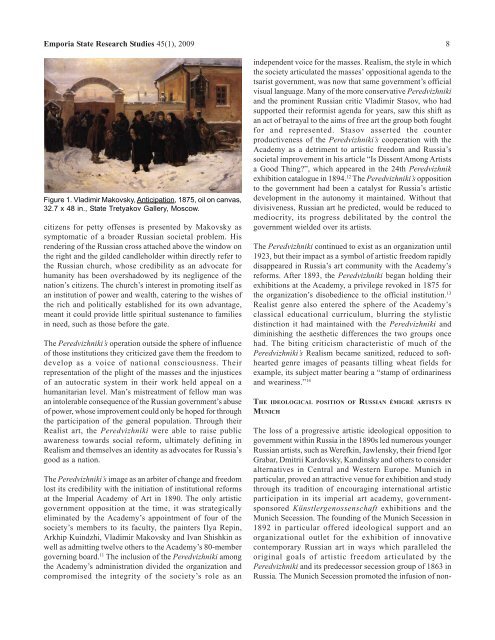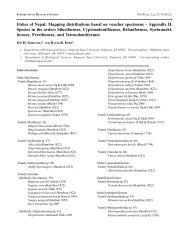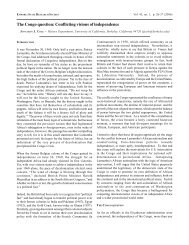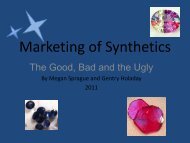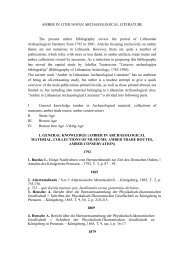Kochman 7of grow<strong>in</strong>g populist <strong>political</strong> unrest <strong>in</strong> the <strong>Russian</strong> Empire <strong>in</strong>the 1890s, the 1904-05 Russo-Japanese War <strong>and</strong> the 1905<strong>Russian</strong> Revolution heightened anti-tsarist sentiment <strong>and</strong> thefear of anarchist upris<strong>in</strong>gs <strong>in</strong> <strong>Munich</strong>. German sensitivityregard<strong>in</strong>g all <strong>Russian</strong> <strong>émigré</strong>s potential <strong>political</strong> alliancesencouraged an overall climate of suspicion, which only<strong>in</strong>creased after the revolution through well-publicizedsearches, <strong>de</strong>tentions <strong>and</strong> arrests by <strong>Munich</strong> police seek<strong>in</strong>g toenforce a law prohibit<strong>in</strong>g <strong>Russian</strong>s from <strong>political</strong> activity <strong>in</strong>Bavaria. <strong>Russian</strong> <strong>émigré</strong> <strong>artists</strong> assumed a <strong>de</strong>fensive posturewith which they had to live <strong>and</strong> work by gradually avoid<strong>in</strong>gsituations <strong>in</strong> which they might become easy public targets topolice <strong>and</strong> anti-<strong>Russian</strong> Germans, by travel<strong>in</strong>g abroad <strong>and</strong>/or work<strong>in</strong>g outsi<strong>de</strong> <strong>Munich</strong> where <strong>political</strong> tensions werehighest, as <strong>in</strong> the small relatively nearby town of Murnau.Ongo<strong>in</strong>g public scrut<strong>in</strong>y over artistic content furtherencouraged an avoidance strategy, as the German governmenthotly <strong>de</strong>bated morality <strong>in</strong> the arts through the Lex He<strong>in</strong>zebill <strong>and</strong> the removal of a Realist pa<strong>in</strong>t<strong>in</strong>g by the Polish artistStanislav Fabianski, From the Empire of the Tsars by thecity’s Künstlergenossenschaft (Artists Association) from itswell-known annual exhibition <strong>in</strong> 1910 re<strong>in</strong>forced the style’sassociation with the tsar. <strong>Russian</strong> <strong>émigré</strong> avant-gar<strong>de</strong> <strong>artists</strong>’belief <strong>in</strong> art’s ability to effect social change was redirectedtowards a less <strong>political</strong>ly controversial path, one of <strong>in</strong>dividual<strong>in</strong>trospection <strong>and</strong> felt experience as its ultimate catalyst.REALISM’S EARLY POLITICAL POSITION IN RUSSIAS<strong>in</strong>ce its found<strong>in</strong>g <strong>in</strong> 1870 <strong>in</strong> St. Petersburg, thePeredvizhniki’s prevail<strong>in</strong>g i<strong>de</strong>ntity was its popular allegiance<strong>and</strong> <strong>opposition</strong> to the tsarist regime. More formally knownas the Tovarishchestvo peredvizhnykh khudozhestvennykhvystavok (Association of Travel<strong>in</strong>g Art Exhibits) the grouphad voiced issues of social <strong>in</strong>justice to the masses throughimages of poverty, hunger <strong>and</strong> class discrim<strong>in</strong>ation. Theiragenda was based on the secession of 14 stu<strong>de</strong>nts from theImperial Aca<strong>de</strong>my of Art <strong>in</strong> 1863, 5 <strong>and</strong> their protest of thetight control <strong>and</strong> restrictions the <strong>in</strong>stitution placed on itsstu<strong>de</strong>nts. The impetus for the act was the govern<strong>in</strong>g board’srejection of the stu<strong>de</strong>nt’s request that they choose a populist,realist-oriented subject for the Big Gold Medal competition, 6rather than the traditional neo-classical theme given by theadm<strong>in</strong>istration. The stu<strong>de</strong>nts withdrew from the competition<strong>and</strong> the Aca<strong>de</strong>my, forfeit<strong>in</strong>g their advancement of civil status<strong>and</strong> the privilege of not pay<strong>in</strong>g taxes, as well as theprofessional <strong>and</strong> f<strong>in</strong>ancial security which came with be<strong>in</strong>gone of the Aca<strong>de</strong>my’s graduates.The symbolic message sent by the stu<strong>de</strong>nts to the <strong>Russian</strong><strong>in</strong>tellectual community <strong>in</strong> 1863 was that they could not bebought by the Aca<strong>de</strong>my nor enticed by the economic <strong>and</strong> socialadvantages it offered. As the Aca<strong>de</strong>my was un<strong>de</strong>r the directauthority <strong>and</strong> control of the tsar, protest aga<strong>in</strong>st the <strong>in</strong>stitutionsignified <strong>opposition</strong> to him as well. 7 Artistic freedom <strong>and</strong>preserv<strong>in</strong>g one’s personal <strong>and</strong> professional <strong>in</strong>tegrity were thefundamental elements of the secessionists’ cause, yet it wasalso paired with a broa<strong>de</strong>r agenda of popular protest <strong>and</strong>greater freedom for the masses which were un<strong>de</strong>rway at thetime. Serfdom had been abolished <strong>in</strong> 1861 <strong>and</strong> the tsaristgovernment’s <strong>in</strong>justice to its people was the press<strong>in</strong>g issueamong <strong>Russian</strong> <strong>in</strong>tellectuals of the period. 8 The Realist style<strong>and</strong> its propensity for documentary-like portrayals of everydaylife became an appropriate vehicle for address<strong>in</strong>g the hardshipof the masses, a practice epitomized <strong>in</strong> the art of thePeredvizhniki. 9Like the earlier secessionists, the Peredvizhniki strove to free<strong>artists</strong> from the “serf-like <strong>de</strong>pen<strong>de</strong>nce” they had been forced<strong>in</strong>to with the Imperial Aca<strong>de</strong>my, <strong>and</strong> <strong>de</strong>dicated themselves to<strong>in</strong>creas<strong>in</strong>g <strong>artists</strong>’ autonomy over their lives <strong>and</strong> professionalcareers. 10 The organization accomplished this with greatersuccess than its pre<strong>de</strong>cessor, as it emerged dur<strong>in</strong>g a time of<strong>in</strong>creased private patronage <strong>and</strong> did not have to rely on theAca<strong>de</strong>my for economic support. Their reformist agenda alsoreached the masses <strong>in</strong> its structure as a travel<strong>in</strong>g exhibitionsociety, by arrang<strong>in</strong>g the appearance of its shows <strong>in</strong> theprov<strong>in</strong>ces after <strong>in</strong>itial venues <strong>in</strong> St. Petersburg <strong>and</strong> Moscow.In do<strong>in</strong>g so, the Peredvizhniki brought the social <strong>and</strong> moralmessages of their work to the people whose lives theyillustrated <strong>and</strong> offered a visual vehicle for the masses to fight<strong>political</strong>ly aga<strong>in</strong>st the government’s <strong>in</strong>justices upon them.Vladimir Makovsky’s pa<strong>in</strong>t<strong>in</strong>g Anticipation, 1875 (Fig. 1) isan example, <strong>in</strong> which he portrayed the faults of thegovernment’s justice system. Here, family <strong>and</strong> friends fromseveral different classes st<strong>and</strong> outsi<strong>de</strong> the walls of Moscow’sDeportation Fortress, expect<strong>in</strong>g the emergence of prisonersfrom its gates. Peasants <strong>and</strong> gentry, mothers, fathers, wives<strong>and</strong> children alike, make up the solemn <strong>and</strong> patient crowd,many weary from wait<strong>in</strong>g <strong>and</strong> travel <strong>in</strong> the w<strong>in</strong>ter weather.The el<strong>de</strong>rly peasant couple on the right sit tiredly on theirsleigh, la<strong>de</strong>n with goods to pass on to their son, the one mostlikely beh<strong>in</strong>d bars. The fur-clad gentleman <strong>in</strong> the centersimilarly waits with a package <strong>in</strong> h<strong>and</strong> for his relation, whilethree other men look through a peephole <strong>in</strong>to the fortressgate for any signs of activity.The long wait the crowd has endured <strong>and</strong> the resignationthey express is juxtaposed by the lengthy sentences theprisoners have been given, their lives lost <strong>in</strong> a failed justicesystem. The prisoners’ complete physical absence from theimage suggests that they <strong>in</strong> fact, will never be reunited withtheir families, to be <strong>de</strong>ported to the <strong>de</strong>pths of Siberia wheretheir fate is unclear. The brief meet<strong>in</strong>g they may have withtheir families will be one of farewells, as the latter see theirloved ones off with no guarantee of return. The justice system’sunfairness <strong>and</strong> <strong>in</strong>discrim<strong>in</strong>ate imprisonment of Russia’s
Emporia State Research Studies 45(1), 2009 8Figure 1. Vladimir Makovsky, Anticipation, 1875, oil on canvas,32.7 x 48 <strong>in</strong>., State Tretyakov Gallery, Moscow.citizens for petty offenses is presented by Makovsky assymptomatic of a broa<strong>de</strong>r <strong>Russian</strong> societal problem. Hisren<strong>de</strong>r<strong>in</strong>g of the <strong>Russian</strong> cross attached above the w<strong>in</strong>dow onthe right <strong>and</strong> the gil<strong>de</strong>d c<strong>and</strong>lehol<strong>de</strong>r with<strong>in</strong> directly refer tothe <strong>Russian</strong> church, whose credibility as an advocate forhumanity has been overshadowed by its negligence of thenation’s citizens. The church’s <strong>in</strong>terest <strong>in</strong> promot<strong>in</strong>g itself asan <strong>in</strong>stitution of power <strong>and</strong> wealth, cater<strong>in</strong>g to the wishes ofthe rich <strong>and</strong> <strong>political</strong>ly established for its own advantage,meant it could provi<strong>de</strong> little spiritual sustenance to families<strong>in</strong> need, such as those before the gate.The Peredvizhniki’s operation outsi<strong>de</strong> the sphere of <strong>in</strong>fluenceof those <strong>in</strong>stitutions they criticized gave them the freedom to<strong>de</strong>velop as a voice of national consciousness. Theirrepresentation of the plight of the masses <strong>and</strong> the <strong>in</strong>justicesof an autocratic system <strong>in</strong> their work held appeal on ahumanitarian level. Man’s mistreatment of fellow man wasan <strong>in</strong>tolerable consequence of the <strong>Russian</strong> government’s abuseof power, whose improvement could only be hoped for throughthe participation of the general population. Through theirRealist art, the Peredvizhniki were able to raise publicawareness towards social reform, ultimately <strong>de</strong>f<strong>in</strong><strong>in</strong>g <strong>in</strong>Realism <strong>and</strong> themselves an i<strong>de</strong>ntity as advocates for Russia’sgood as a nation.The Peredvizhniki’s image as an arbiter of change <strong>and</strong> freedomlost its credibility with the <strong>in</strong>itiation of <strong>in</strong>stitutional reformsat the Imperial Aca<strong>de</strong>my of Art <strong>in</strong> 1890. The only artisticgovernment <strong>opposition</strong> at the time, it was strategicallyelim<strong>in</strong>ated by the Aca<strong>de</strong>my’s appo<strong>in</strong>tment of four of thesociety’s members to its faculty, the pa<strong>in</strong>ters Ilya Rep<strong>in</strong>,Arkhip Ku<strong>in</strong>dzhi, Vladimir Makovsky <strong>and</strong> Ivan Shishk<strong>in</strong> aswell as admitt<strong>in</strong>g twelve others to the Aca<strong>de</strong>my’s 80-membergovern<strong>in</strong>g board. 11 The <strong>in</strong>clusion of the Peredvizhniki amongthe Aca<strong>de</strong>my’s adm<strong>in</strong>istration divi<strong>de</strong>d the organization <strong>and</strong>compromised the <strong>in</strong>tegrity of the society’s role as an<strong>in</strong><strong>de</strong>pen<strong>de</strong>nt voice for the masses. Realism, the style <strong>in</strong> whichthe society articulated the masses’ <strong>opposition</strong>al agenda to thetsarist government, was now that same government’s officialvisual language. Many of the more conservative Peredvizhniki<strong>and</strong> the prom<strong>in</strong>ent <strong>Russian</strong> critic Vladimir Stasov, who hadsupported their reformist agenda for years, saw this shift asan act of betrayal to the aims of free art the group both foughtfor <strong>and</strong> represented. Stasov asserted the counterproductiveness of the Peredvizhniki’s cooperation with theAca<strong>de</strong>my as a <strong>de</strong>triment to artistic freedom <strong>and</strong> Russia’ssocietal improvement <strong>in</strong> his article “Is Dissent Among Artistsa Good Th<strong>in</strong>g?”, which appeared <strong>in</strong> the 24th Peredvizhnikexhibition catalogue <strong>in</strong> 1894. 12 The Peredvizhniki’s <strong>opposition</strong>to the government had been a catalyst for Russia’s artistic<strong>de</strong>velopment <strong>in</strong> the autonomy it ma<strong>in</strong>ta<strong>in</strong>ed. Without thatdivisiveness, <strong>Russian</strong> art he predicted, would be reduced tomediocrity, its progress <strong>de</strong>bilitated by the control thegovernment wiel<strong>de</strong>d over its <strong>artists</strong>.The Peredvizhniki cont<strong>in</strong>ued to exist as an organization until1923, but their impact as a symbol of artistic freedom rapidlydisappeared <strong>in</strong> Russia’s art community with the Aca<strong>de</strong>my’sreforms. After 1893, the Peredvizhniki began hold<strong>in</strong>g theirexhibitions at the Aca<strong>de</strong>my, a privilege revoked <strong>in</strong> 1875 forthe organization’s disobedience to the official <strong>in</strong>stitution. 13Realist genre also entered the sphere of the Aca<strong>de</strong>my’sclassical educational curriculum, blurr<strong>in</strong>g the stylisticdist<strong>in</strong>ction it had ma<strong>in</strong>ta<strong>in</strong>ed with the Peredvizhniki <strong>and</strong>dim<strong>in</strong>ish<strong>in</strong>g the aesthetic differences the two groups oncehad. The bit<strong>in</strong>g criticism characteristic of much of thePeredvizhniki’s Realism became sanitized, reduced to softheartedgenre images of peasants till<strong>in</strong>g wheat fields forexample, its subject matter bear<strong>in</strong>g a “stamp of ord<strong>in</strong>ar<strong>in</strong>ess<strong>and</strong> wear<strong>in</strong>ess.” 14THE IDEOLOGICAL POSITION OF RUSSIAN ÉMIGRÉ ARTISTS INMUNICHThe loss of a progressive artistic i<strong>de</strong>ological <strong>opposition</strong> togovernment with<strong>in</strong> Russia <strong>in</strong> the 1890s led numerous younger<strong>Russian</strong> <strong>artists</strong>, such as Werefk<strong>in</strong>, Jawlensky, their friend IgorGrabar, Dmitrii Kardovsky, K<strong>and</strong><strong>in</strong>sky <strong>and</strong> others to consi<strong>de</strong>ralternatives <strong>in</strong> Central <strong>and</strong> Western Europe. <strong>Munich</strong> <strong>in</strong>particular, proved an attractive venue for exhibition <strong>and</strong> studythrough its tradition of encourag<strong>in</strong>g <strong>in</strong>ternational artisticparticipation <strong>in</strong> its imperial art aca<strong>de</strong>my, governmentsponsoredKünstlergenossenschaft exhibitions <strong>and</strong> the<strong>Munich</strong> Secession. The found<strong>in</strong>g of the <strong>Munich</strong> Secession <strong>in</strong>1892 <strong>in</strong> particular offered i<strong>de</strong>ological support <strong>and</strong> anorganizational outlet for the exhibition of <strong>in</strong>novativecontemporary <strong>Russian</strong> art <strong>in</strong> ways which paralleled theorig<strong>in</strong>al goals of artistic freedom articulated by thePeredvizhniki <strong>and</strong> its pre<strong>de</strong>cessor secession group of 1863 <strong>in</strong>Russia. The <strong>Munich</strong> Secession promoted the <strong>in</strong>fusion of non-


